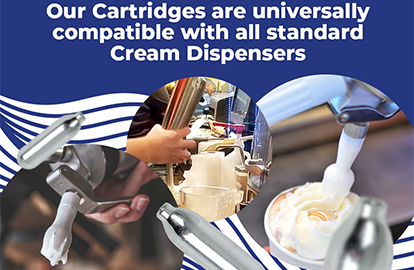TopWhip Cream Chargers: Understanding Safe Handling and Usage of Nitrous Oxide (N2O)
Ensuring Safety and Responsibility with N2O Cream Chargers
At TopWhip, safety is our utmost priority. We are committed to providing our customers with high-quality cream chargers and educating them on the responsible handling and usage of nitrous oxide (N2O). N2O is a colorless, odorless gas commonly used in the culinary world for whipping cream and creating delicious foams and mousses. However, it's essential to understand the potential hazards associated with N2O and follow proper safety guidelines.
Understanding the Risks of N2O
Nitrous oxide, also known as laughing gas, is a compressed liquefied gas stored under high pressure within cream chargers. While it has various legitimate applications, it's crucial to recognize the potential risks:
- Oxidizing Gas: N2O can accelerate combustion and support fires. Keep cream chargers away from flames and flammable materials.
- Pressurized Gas: Cream chargers contain N2O under high pressure. Exposure to heat can cause them to explode. Never expose them to direct sunlight or high temperatures.
- Health Effects: Inhaling N2O can lead to dizziness, drowsiness, and in severe cases, asphyxiation. Always use cream chargers in well-ventilated areas and avoid direct inhalation.
Safe Handling and Storage Practices
To ensure the safe use of TopWhip cream chargers, follow these essential guidelines:
- Store Properly: Keep cream chargers in a cool, dry, and well-ventilated area away from direct sunlight and heat sources.
- Handle with Care: Always handle cream chargers with care to avoid puncturing or damaging them.
- Use as Directed: Only use cream chargers with whipped cream dispensers designed for N2O.
- Ventilation: Ensure adequate ventilation when using cream chargers to prevent the buildup of N2O gas.
- Disposal: Dispose of used cream chargers responsibly according to local regulations.
TopWhip's Commitment to Safety
TopWhip is dedicated to promoting the safe and responsible use of N2O cream chargers. We provide clear safety instructions on our packaging and website, and we actively educate our customers on best practices.
By understanding the potential risks and following proper safety guidelines, you can enjoy the culinary benefits of N2O cream chargers while ensuring your well-being and the safety of those around you.
FAQ
-
Can I recycle N2O and CO2 chargers?
Both the CO2 (seltzer) and N2O (whip cream) chargers are made of steel and can be recycled. We encourage you to your local recycling program with any specific questions regarding their safe disposal.
-
How do I use nitrous oxide (N2O) chargers (whippets)?
Making delicious whip cream with our nitrous oxide chargers and dispensers is extremely easy. Nitrous Oxide gas is used in the preparation of whipped cream recipes and other foam creations like espuma and mousse desserts. Do not use the carbon dioxide (CO2) Soda chargers you find on our site for whipping cream or espuma preparation, the result will be carbonated cream. Essentially, the "stabilizing agents" in the liquid bind with the nitrous oxide to create a foam. These stabilizing agents are the milk fats, gelatins, or some other material. Nitrogen is a naturally occurring gas in the air we breathe, and in fact accounts for approximately 80% of our atmosphere. This gas is responsible for binding to the milk fats when you prepare the whipped cream with a whisk. The whip cream canisters and nitrous oxide chargers we sell make the process much easier and more predictable. Each charger contains 8 grams of pure nitrous oxide which is adequate for up to 1 pint of liquid whipping cream. Detailed instructions about the use of nitrous oxide whip cream chargers (whippets) whipped cream dispensers (whippers) are included with every order.
-
My cream whipper is not producing fluffy cream?
Wenn dein Sahneschlepper nicht die gewünschte Konsistenz der Sahne produziert, kann es daran liegen, dass du die Sahneschlepper überfüllst oder sie nicht genug schüttelst, bevor du sie abgibst. Achten Sie darauf, die Anweisungen des Herstellers für die richtige Menge Creme zu verwenden und die richtige Schütteltechnik zu befolgen. Wenn das Problem weiterhin besteht, versuchen Sie, eine andere Creme zu verwenden oder die Menge des verwendeten N2O-Gases anzupassen.
-
Can I use any brand of N2O cartridges with my cream whipper?
It is recommended to use only high-quality N2O cartridges that are specifically designed for cream whippers. Using low-quality or off-brand cartridges can affect the performance of your whipper and may even damage it. Always check the manufacturer's recommendations for compatible cartridges.
-
How do I clean my N2O cream whipper?
To clean your cream whipper, first remove any remaining cream or liquid from the dispenser. Then, disassemble the whipper and wash each part with warm, soapy water. Be sure to thoroughly rinse and dry each part before reassembling the whipper. Avoid using abrasive cleaners or harsh chemicals, as these can damage the whipper.
-
My cream whipper is leaking gas. What should I do?
If you notice gas leaking from your N2O cream whipper, first check to make sure that the cartridge is properly inserted and tightened. If the leak continues, it may be a sign that the seal in the whipper is damaged. In this case, you may need to replace the seal to prevent further leaks.
-
Why is my N2O cream whipper not dispensing properly?
This could be due to a few reasons. First, make sure that the N2O cartridge is properly inserted and tightened. If it is, then the issue may be with the whipper itself. Try cleaning the nozzle and dispenser head to ensure there are no blockages. If the problem persists, it may be time to replace the dispenser head.
-
What are the potential environmental impacts of N2O production?
N2O is a potent greenhouse gas that contributes to global warming and ozone depletion. Its production can also lead to the release of nitrogen oxides, which can contribute to air pollution and acid rain.






